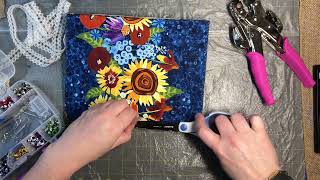How To Ventilate/Make A 5By5 Closure/Very Detailed & Beginner Friendly
- Posted on 29 October, 2022
- Lace Closure
- By Anonymous
Hello lovelies, welcome to my Youtube channel. I make tutorials on hair and E-commerce and more. Please subscribe and turn on your notification so that you will be notified whenever I post a new video.
I tried as much as I could to simplify this tutorial on 5by5 closure ventilation but if you have any question, kindly drop it in the comment section.
Music: With you in the morning
Musician: Carl Storm
You can contact me for business or enquiry on my Instagram business account @Fizzys_hairmpire
Please watch my other hair tutorials using the links below:
Watch my video on how to ventilate a T-frontal using a T-frontal wig cap using the link below.
Watch my video on how to construct and ventilate a 2 by 4 closure from the scratch using the link below
Hello welcome to my YouTube channel and in this video I'm going to show you how I constructed this 5x5 closure. Please watch this video to the end, because I'm just going to give you all you need for the process and that will be whole if you have not subscribed to this channel kindly consider subscribing and give this video a thumbs up. Let'S get right into the video five closure, knit five by five place it here so this place. You can see it's five centimeter and from here to place it here here, five by five, when you're five by five four by four, it means the measurement of the net. So the same way, you ventilate a four by four key you're assume we immensely it's a five by five closure, so this one three is also a five this place from here. The length now is five centimeter and the width two is five centimeter now you say what what about this extra knit are these parts here today? This one is for the installation. They are going to you're going to call this place and when you want to install this closure on your head or on your client's head. So if you look at this closure closely, if you look at the closure closely, there is a line marked here. There'S a line here marked here, so that is where the five centimeter for the length ends. That is where it ends. So I'm going to place the tape room here now. Look at this. This is where the line interview. If you look closely, you can see that there's a thickness from here to here, but if you look at it from here to here, the net is lightest because of the thickness. That'S where the five centimeter ends on this part. So that is how you know the measurements, the same thing with your four by four there's: all there has to be an extra one centimeter for the installation where you want to install it. So that is why you have this extra in front extra net in front of it. So when you want to ventilate now you place it on the dummy head. So now I'm trying to pin the lace closure to the dummy head. So I placed the paper underneath the net fold to make the holes more visible, because if you place it directly on this dummy head, it's not going to be as visible as this and to make your ventilation work faster. You need to clear you need the holes to be as clear as they can be so now you're going to pin it down, I'm using a t pin so for the front before you pin it at the front. So you have to you. Have you can see this line now? This is where our ventilation is going to stop. That is where the five centimeter ends. That'S what I was trying to explain earlier so from for us to get the middle part, because we are going to create a closure um. The closure part at the center, so this five by five right. So that means the mid is going to be two points. It'S going to be 2.5. I'Ve already pinned it at the front here this is 2.5 centimeter. So this is where the middle part is going to be so we start our ventilation now. So this is how you ventilate. You pick one hole you're going to pick one all like this at the tip of this ventilating needle there's, something like an hack like. I don't know if it's very tiny, so I don't know if it's going to show on this camera but as you can see this tiny hook in front of it. So that's what we always use to hook the hair when we put it inside the oil. So this is what we're going to do now. Put it here like this, you pick two to three strands at the back. You bring it out of the hole and you knot it you bring it back and not. This is what we call single, nothing method, nothing, but I, when I'm working with human hair, I prefer to use the double knotting or double splits, nothing method. So for this video, for the sake of this video, I'm going to for this video, I'm going to use a Double Split knot method, so I'm going to pull it out now of the half, then go back and pick the other parts and knot it. This is going to secure it properly. Then I'm going to do the same thing here, I'll pick two to three strands: bring it out of the oil. Just take one half of this knot, it take the other part and not so that's what I'm going to do. I'M going to ventilate one centimeter forward to the back like this like this, then, when I get to the front after ventilating that, but I'm going to take it like vertical practical lines. So at this point now I have ventilated one centimeter forward. The reason why is this the front? This is the front of the lace right this part, and this is the back. I have to do the diagonal ventilation, but diagonal I mean I was ventilating this way like this. If you look at the Nets closely, you can see that the lines they can they go in the diagonal weight, see they go. This way see it's not totally horizontal. It'S not straight like this, but you can take it like this, so I did that so that everything I'm trying to cover this lace at the back, because when you want to sew the webs to the wig, you need some part of the closure to cover it. So that was that was the idea behind this. So now I'm going to from here - and I start ventilating straight down because initially I told you - I was going to make leave two lines in the middle to form the middle part for the closure. But now I just got an instruction from this client that she doesn't want a middle part anymore, that she wants to be a free part, five by five closure, so you can keep going this way, keep going this way to get the front. At the same time. Now I can decide to start ventilating this way. So it's totally hot to me now since then, since I'm not creating the middle part, then there is no need to say: okay, I must take. I must leave too straight lines and follow this vertical um wait anymore. Do you understand so I'm going to ventilate now and I'm going to show you the end results. So, basically, now I'm just trying to ventilate the lines straight down. I'M picking the lines vertically I'm ventilating straight down and, as you can see, I'm using the Double Split nut method, the reason being that it secures the knots properly and but, if you're new to if you're new to ventilation, I would say you should start with the Single knotting method, you don't know that, try to master that yet because this one can be quite um difficult for you, especially as a beginner. So that's what I'm just going to do. I'M going to show you how it looks at the end, please if you have not subscribed kindly click the Subscribe button and give this video a thumbs up. So this is the final outcome guys, as you can see in this video. I made two for this particular client, so that's basically how you construct your 5x5 closure and I can see the extra lace in front that one now that part is going to be cut off when you are installing the wig. Please give this video a thumbs up and I'll see you in my next video. Thank you.





Comments
Blessing Aina: Very easy to understand
kemi adeleke: 5 inches not centimeter. Centimeters is on the ithe side of the taperule